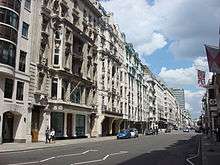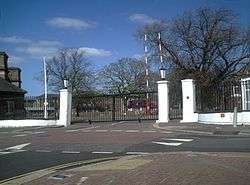Eastern Command (United Kingdom)
| Eastern Command | |
|---|---|
_Badge.jpg) | |
| Active | 1793–1972 |
| Country |
|
| Branch |
|
| Type | Command |
| Garrison/HQ |
Colchester (1866–1905) London (1905–1939) Luton Hoo (1939–1945) Hounslow (1945–1954) Wilton Park (1954–1972) |
Eastern Command was a Command of the British Army.
Nineteenth century





Great Britain was divided into military districts on the outbreak of war with France in 1793.[1] In the first half of the 19th century the command included the counties of Essex, Suffolk, Norfolk, Cambridgeshire, Huntingdonshire and Hertfordshire.[2] It was based in Colchester.[3]
Disbanded after the Napoleonic Wars, the Eastern District Command was re-created in 1866[4][5] and was based at Flagstaff House in Colchester.[6] In January 1876 a ‘Mobilization Scheme for the forces in Great Britain and Ireland’ was published, with the ‘Active Army’ divided into eight army corps based on the District Commands. 1st Corps was to be formed within Eastern Command, based in Colchester. This scheme disappeared in 1881, when the districts were retitled ‘District Commands.[7]
Twentieth century
The 1901 Army Estimates introduced by St John Brodrick allowed for six army corps based on six regional commands. As outlined in a paper published in 1903, IV Corps was to be formed in a reconstituted Eastern Command, with HQ at London.[8] Lieutenant General Lord Grenfell was appointed acting General Officer Commanding-in-Chief (GOCinC) of IV Corps in April 1903.[9]
First World War
Army Order No 324, issued on 21 August 1914, authorised the formation of a 'New Army' of six Divisions, manned by volunteers who had responded to Earl Kitchener's appeal (hence the First New Army was known as 'K1'). Each division was to be under the administration of one of the Home Commands, and Eastern Command formed what became the 12th (Eastern) Division.[10] It was followed by 18th (Eastern) Division of K2 in September 1914.[11] During the First World War, Eastern Command was based at 50 Pall Mall, London.[12]
Second World War
By 1939 its headquarters was located at Horseguards in London.[13] At that time Regular Troops reporting to the Command included 4th Infantry Division.[13] During the Second World War, the Command relocated to Luton Hoo in Bedfordshire.[14] During the war, the 76th Infantry (Reserve) Division was assigned to the command as its training formation.[15]
Post War
After the War the command moved to Hounslow Barracks in Hounslow.[16] When the Territorial Army was reformed in 1947, 54th (East Anglian) was not reconstituted as a field division, but 161st Infantry Brigade was reformed as an independent infantry brigade in Eastern Command.[17] The command moved to Wilton Park in Beaconsfield in 1954.[18] It was merged into HQ UK Land Forces (HQ UKLF) in 1972.[19]
General Officers Commanding-in-Chief
GOCs and GOCinCs have included:[20][21][22]
General Officer Commanding Eastern District
- 1795 – 1800 General Sir William Howe[23]
- 1801 – 1802 General the Marquess Cornwallis[24]
- 1802 – 1805 Major General Sir James Craig[25]
- 1805 – 1806 Major General Sir James Pulteney[26]
- 1806 – 1814 Lieutenant General Lord Chatham[27]
- 1815 – 1819 Major General Sir John Byng[28]
- 1866 – 1869 Major General Thomas Tidy
- 1869 – 1870 Major General Richard Farren
- 1870 – 1872 Lieutenant General Freeman Murray
- 1872 Lieutenant General the Hon. Alexander Hamilton-Gordon
- 1872 – 1877 Major General Sir Edward Greathed
- 1877 – 1878 Lieutenant General Sir Richard Kelly
- 1878 – 1882 Lieutenant General William Pollexfen Radcliffe
- 1882 Major General the Hon. Sir Henry Clifford
- 1882 – 1886 Lieutenant General Robert White
- 1886 – 1889 Major General Sir Evelyn Wood
- 1889 – 1892 Major General Henry Buchanan
- 1892 – 1896 Lieutenant General John Glyn
- 1896 – 1898 Major General Charles Burnett
- 1898 – 1899 Major General Sir William Gatacre
- 1899 – 1900 Major General Henry Abadie
- 1900 – 1903 Major General Sir William Gatacre (also commander 10th Division and 19th Brigade from 1 April 1903[9])
- 1903 – 1904 Major General Herbert Plumer[29]
- 1904 – 1905 Major General Arthur Wynne[30]
10th Division was renamed 6th Division in 1905.
Commander 4th Army Corps
Home District at Horse Guards, Eastern District at Colchester, Thames District at Chatham and Woolwich District were grouped under 4th Army Corps in 1903.
- 1 April 1903: General the Lord Grenfell[9]
- 6 June 1904: General the Lord Methuen[31]
4th Army Corps was renamed Eastern Command 1 June 1905.
General Officer Commanding Eastern Command
- 1905 – 1908 Lieutenant General Lord Methuen
- 1908 – 1912 Lieutenant General Sir Arthur Paget
- 1912 – 1914 Lieutenant General Sir James Grierson
- 1914 – 1915 Lieutenant General Sir Charles Woollcombe
- 1915 – 1916 Lieutenant General Sir Leslie Rundle
- 1916 – 1917 Lieutenant General Sir James Wolfe-Murray
- 1917 – 1918 Lieutenant General Sir Henry Wilson
- 1918 General Sir William Robertson
- 1918 – 1919 Lieutenant General Sir Charles Woollcombe
- 1919 – 1923 General Lord Horne
- 1923 – 1926 Lieutenant General Sir George Milne
- 1926 – 1927 Lieutenant General Sir Walter Braithwaite
- 1927 – 1931 General Sir Robert Whigham
- 1931 – 1933 General Sir Webb Gillman
- 1933 – 1936 Lieutenant General Sir Cyril Deverell
- 1936 – 1938 Lieutenant General Sir Edmund Ironside
- 1938 – 1941 Lieutenant General Sir Guy Williams
- 1941 – 1942 Lieutenant General Laurence Carr
- April 1942 – August 1942 Lieutenant General Sir Kenneth Anderson
- September 1942 – January 1944 Lieutenant General Sir James Gammell
- January 1944 – December 1944 Lieutenant General Sir Kenneth Anderson
- December 1944 – August 1945 Lieutenant General Sir Alan Cunningham
- 1945 – 1947 Lieutenant General Sir Oliver Leese
- 1947 – 1950 General Sir Evelyn Barker
- 1950 – 1952 General Sir Gerald Templer
- 1952 – 1953 Lieutenant General Sir George Erskine
- 1953 – 1954 Lieutenant General Sir Geoffrey Bourne
- 1954 – 1956 Lieutenant General Sir Francis Festing
- 1956 – 1959 Lieutenant General Sir Charles Coleman
- 1959 – 1960 Lieutenant General Sir James Cassels
- 1960 – 1961 General Sir Gerald Lathbury
- 1962 – 1965 Lieutenant General Sir Roderick McLeod
- 1965 – 1966 Lieutenant General Sir George Cole
- 1966 – 1968 Lieutenant General Sir David Peel Yates
References
- ↑ Robert Burnham and Ron McGuigan, The British Army Against Napoleon: Facts, Lists and Trivia, 1805–1815 (2010) p. 7.
- ↑ Trollope, Anthony (2014). "An Autobiography: and Other Writings". Oxford University Press. p. 86. ISBN 978-0199675289.
- ↑ "The Gentleman's Magazine, and Historical Chronicle, Volume 97, Part 2". 1827. Retrieved 20 December 2015.
- ↑ Pevsner, p 282
- ↑ "'Barracks', in A History of the County of Essex: Volume 9, the Borough of Colchester, ed. Janet Cooper and C R Elrington". London. 1994. p. 251-255. Retrieved 18 December 2015.
- ↑ "Roman circus foundations uncovered at Flagstaff House". The Colchester Archaeologist. Retrieved 23 November 2015.
- ↑ Army List 1876–1881.
- ↑ Col John K. Dunlop, The Development of the British Army 1899–1914, London: Methuen, 1938.
- 1 2 3 "No. 27545". The London Gazette. 21 April 1903. p. 2527.
- ↑ "12th Division". The long, long trail. Retrieved 14 December 2015.
- ↑ "18th Division". The long, long trail. Retrieved 14 December 2015.
- ↑ Jeffery, p. 198
- 1 2 Patriot Files
- ↑ Discover Bedfordshire Archived June 10, 2008, at the Wayback Machine.
- ↑ Forty 2013, Reserve Divisions.
- ↑ TA Heathcote, The British Field Marshals 1736–1997, Pen & Sword Books, Published 1999, ISBN 0-85052-696-5, Page 120
- ↑ Watson, TA 1947. Archived December 5, 2013, at the Wayback Machine.
- ↑ Subterranea Britannica
- ↑ "Army Command Structure (United Kingdom)". Hansard. 17 December 1970. Retrieved 15 December 2015.
- ↑ Whitaker's Almanacks 1905 – 1972
- ↑ Eastern Command at Regiments.org
- ↑ "Army Commands" (PDF). Archived from the original (PDF) on 4 March 2016. Retrieved 21 November 2015.
- ↑ "William Howe, 5th Viscount Howe". Oxford Dictionary of National Biography. Retrieved 19 December 2015.
- ↑ Wickwire (1980), pp. 252–253
- ↑ "Craig, James Henry". Oxford Dictionary of National Biography. Retrieved 19 December 2015.
- ↑ Philippart, John (1816). "The Royal Military Calendar".
- ↑ "Lord Chatham’s aides-de-camp at Walcheren, 1809". Retrieved 20 December 2015.
- ↑ David R. Fisher and Stephen Farrell, BYNG, Sir John (1772–1860), of 6 Portman Square, Mdx. and Bellaghy, co. Londonderry in The History of Parliament: the House of Commons 1820–1832, ed. D.R. Fisher, 2009
- ↑ "No. 27625". The London Gazette. 11 December 1903. p. 8198.
- ↑ "No. 27659". The London Gazette (Supplement). 18 March 1904. p. 1792.
- ↑ "No. 27684". The London Gazette. 10 June 1904. p. 3711.
Sources
- Forty, George (2013) [1998]. Companion to the British Army 1939–1945 (ePub ed.). New York: Spellmount. ISBN 978-0-7509-5139-5.
- Jeffery, Keith (2006). Field Marshal Sir Henry Wilson: A Political Soldier. Oxford University Press. ISBN 978-0-19-820358-2.
- Pevsner, Nikolaus (1965). Essex (Pevsner Architectural Guides: Buildings of England). Yale University Press. ISBN 978-0300096019.
- Wickwire, Franklin and Mary (1980). Cornwallis: The Imperial Years. Chapel Hill: University of North Carolina Press. ISBN 0-8078-1387-7.